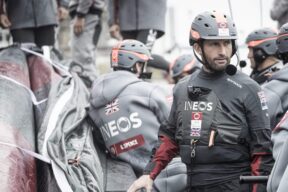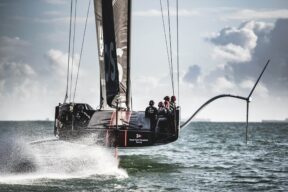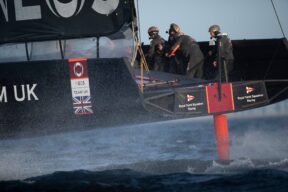Revolutionising INEOS TEAM UK’s America’s Cup Boat Development with Chimera

At a Glance
- Bringing existing tools together for seamless interoperability
- Software crafted to configure and solve complex models efficiently
- Delivered to Windows desktop
- Agile methodology continuously delivered over six months
The Backstory
America’s Cup began life in the shop window of famous London jewellers; an elaborate silver ewer crafted in 1848 by Garrards. It was bought by Henry Paget, Marquess of Anglesey and in 1851 given to the Royal Yacht Squadron as the winner’s prize for a race around the Isle of Wight.
The prize was won by a yacht called America and left British shores for the New York Yacht Club. A few years later it was renamed the America’s Cup and gifted again; this time as the prize for a challenge competition open to yacht clubs of all nations. No one could have known just how famous it would subsequently become as sailing’s premier international trophy.
The Cup became legendary for the longest winning streak in sport – it took 132 years to beat the Americans for the first time, and it wasn’t the British who did it. In 1983 the Australians won an epic match 4-3 to take the Cup back to Perth in Western Australia. Since then it’s been back to the States, on to New Zealand, then Switzerland (although it was sailed in Valencia in Spain), then the USA again and finally back to New Zealand where it now resides.
Britain has yet to win the trophy that started life with a race around the Isle of Wight, but now Ben Ainslie – the four-time Olympic gold medallist – has combined with the founder, Chairman and major shareholder of INEOS, Jim Ratcliffe to form INEOS Team UK and to finally win it back.
The 36th contest for America’s Cup will be held in Auckland in March 2021. It will be raced in the AC75; a brand-new concept of boat developed by the New Zealand team that holds the Cup. The first boats were launched late in 2019 and we expect them to exceed fifty miles an hour on the fastest legs of the course.
The Challenge
The hull of the AC75 is a little under 68 feet long, with the rest of the eponymous 75 feet in the bowsprit. It’s a monohull, or single-hulled boat, driven by a soft-wingsail, and it will fly above the ocean supported by one or other of two T-foils. They will be controlled by a battery-powered, hydraulically actuated and human-initiated system.
This boat presents many technical challenges that are still very new to the sport of sailing, and some of these are closer to those faced in aerospace, motorsport and other industries than they are to those traditionally dealt within America’s Cup. And so INEOS Team UK has gone looking for help from businesses who can offer new and innovative technologies — and one of them was Coderus.
America’s Cup has always been a design and technology contest as much as a sailboat race, but the current set of rules doubles down on the emphasis. The new concept of the boat has a very open set of parameters that encourage rather than limit innovation, particularly in hull, foil and systems design. This alone would make the 36th America’s Cup a different competition from many of those that have gone before, but other changes to the rules have shifted the emphasis to the designers even further.
The new rules have banned testing in wind tunnels and towing tanks. They have also banned teams from sailing more than one boat at a time. In doing so they have banned all the normal ‘real’ (as opposed to virtual) methods of development. The traditional way of testing America’s Cup boats was to prepare two boats (A and B, one a control, the other a known variation). The boats would be sailed against each other in choreographed line-ups, sailing for a few minutes to see which was faster. This would be repeated many times to try and eliminate the other variables (crew, wind speed and direction, etc). The idea was that the test could be repeated until a pattern emerged from the noise in the data, and either A or B would be revealed as faster.
This methodology was used because it is difficult to measure the necessary performance parameters with sensors accurate enough to see the deltas being tested. When a race car goes to the track to test, the rate of fuel consumption, the engine’s power output and the car’s speed and lap times are all measurable to a high degree of accuracy.
In contrast, the wind is the power input for a sailboat, and the boat’s consequent speed through the water and angle to the wind is the performance outputs – none of these is easily or accurately measurable. This was why two-boat testing became the gold standard for America’s Cup teams. The performance (ie. the speed and angle sailed to the wind) was directly revealed by the winner of the test. The consequence of the New Zealanders banning two-boat testing for the 36th America’s Cup has been a dramatic shift in emphasis to the virtual environment.

The Methodology
The speed with which ideas can be assessed in this virtual environment – without compromising the fidelity of the answers – may well be definitive in the outcome of the 36th America’s Cup. Every new concept for an improved hull or foil design has traditionally gone through a process of steps, each one examining the idea with increasing accuracy. Each step costs more time and computer power than the one before – the final computational fluid dynamics (CFD) run that will provide a comprehensive answer might cost tens of thousands of pounds and take days to complete.
So the goal is to winnow out the weak ideas and only commit the very best to the substantial resource requirements of this final test… but to do it with sufficient accuracy that no good ideas get cut too early. Part of the answer is having enough compute resources to get more accurate solutions faster at every stage of the process, but it’s also important to streamline the workflow, the process by which ideas travel from someone’s inspiration to each new test.
One of the hindrances to a streamlined workflow is that each step requires the idea to be represented in a different digital format. The velocity prediction program (VPP) needs something different to CFD and so on. And if the idea is new (as opposed to a variation on an existing theme) it can go nowhere unless someone translates it into a computer-aided design (CAD) model. All this can be frustrating for the concept designer, as they may not have the skills necessary to ‘create’ the model in the required digital format.
INEOS Team UK set the goal of removing the frustrations and hold-ups inherent in this process through a project code-named Chimera. The goal of Chimera was to make it possible for a designer to sketch an idea on the screen and for that idea to be able to travel seamlessly and without further intervention all the way to the final CFD run – if, of course, the idea were good enough.
Chimera was a big software project, but it had the potential to be a game-changer in the speed and accuracy with which innovation and design creativity could be handled. It would take a sketched design and add it to a model of the whole boat, running it through the team’s Velocity Prediction Program (VPP) to see if it made the boat faster or slower. If the results of this were promising, then Chimera would take that model and prepare it for a full simulation run across many different boat states in the team’s CFD program.
The Tech_
- Configure boat parameters and forces through a PyQt application
- Visualise designs and state through Open Cascade 3D models
- Create velocity prediction program solution algorithms
- Solve boat and force configurations for performance using C++ and Python multiprocessing
- Synchronise separate applications using Java and Python implementations of ZMQ Inter-process communications
- Explore and compare solutions using JavaFX based UI


The Results
As a Cypress Design Partner, a Microchip App Developer Specialist and an Authorised Design Centre for Qualcomm – we brought our expertise in application development and high-quality user interfaces to the team to develop the UI for Chimera. This is software that now sits at the very heart of the team’s creative design process.
Having been a team partner for the previous challenge for the 35th America’s Cup, we quickly understood the needs of the team’s competitive environment and, working with Nick Holroyd and INEOS TEAM UK, created a unique and innovative software that has significantly improved the design team’s workflow and increased the throughput of ideas in both speed and accuracy.